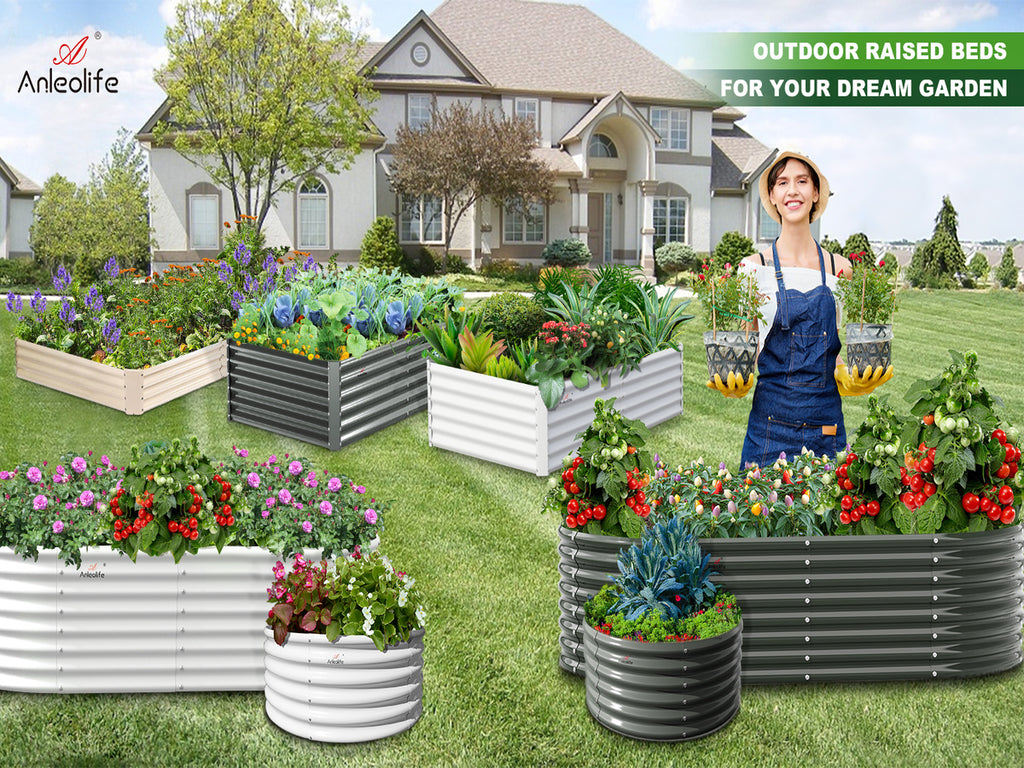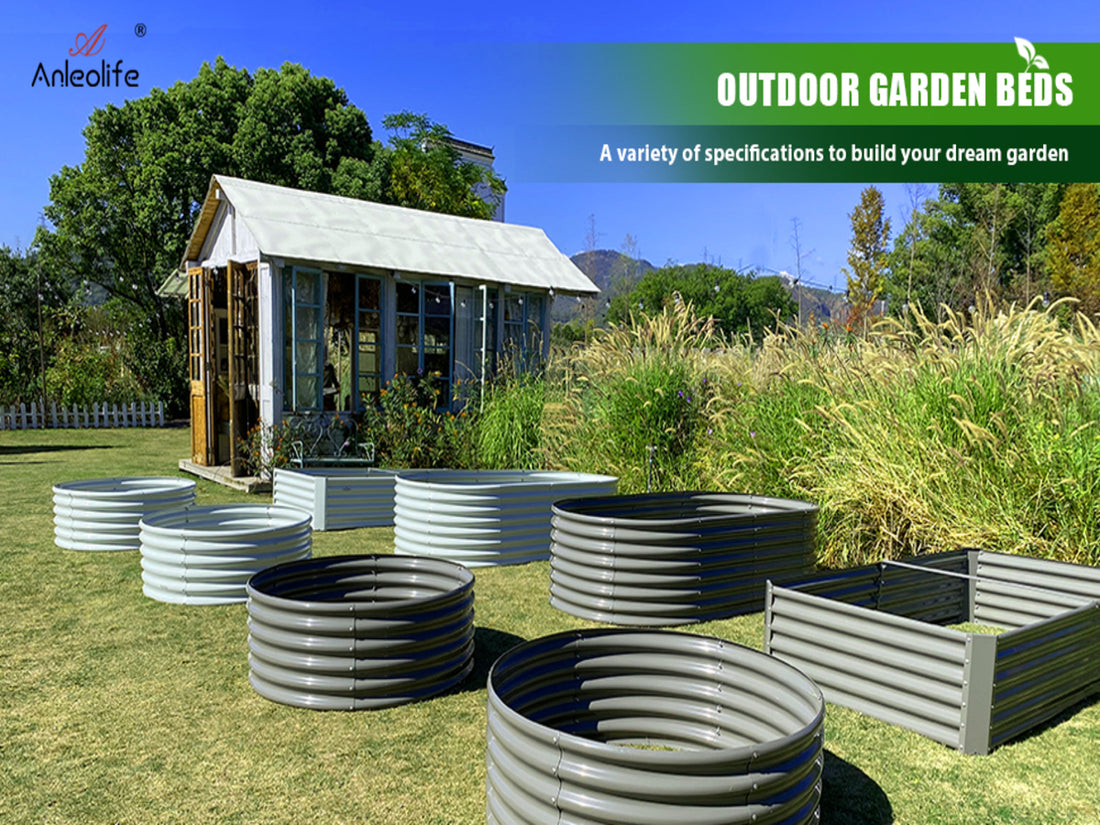|
Material |
Lifespan |
Cost Comparison |
Maintenance |
Features |
|
Cedar Wood |
10-15 years |
20-30% higher than softwoods |
Low |
Resistant to decay, rot, insects; cost-effective over time |
|
Redwood |
15-20 years |
Up to 40% higher than cedar |
Low |
Naturally rot and pest-resistant; aesthetically pleasing |
|
Composite Wood |
Over 20 years |
50% higher than traditional wood |
Very low |
Resists rot, decay, pests; eco-friendly (up to 95% recycled) |
|
Galvanized Steel |
More than 20 years |
60% higher than wood |
Very low |
Modern look; immune to rot, decay, pests; can heat up |
|
Stone, Brick, or Concrete |
Indefinitely |
Double or triple wood cost |
Low |
Permanently durable; resistant to rot and pests |
|
Recycled Plastic or HDPE |
Several decades |
30-40% higher than wood |
Very low |
Immune to rot and pests; eco-friendly (100% recycled) |
|
Cinder Blocks |
Long-lasting |
25-50% less than wood |
Low |
Durable; modular; heavy; cost-effective |
When speaking of setting up a garden, raised beds offer numerous advantages, from improved soil conditions to better pest control. However, the secret to a successful raised garden bed lies in the material you choose. It determines not only the bed's durability but also affects its maintenance and aesthetic appeal.
Today, we'll explore the 7 top materials for constructing long-lasting raised garden beds, comparing their lifespan, cost, and care requirements. Whether you're a seasoned gardener or a beginner, understanding these materials will help you make an informed decision tailored to your garden's needs and your personal preferences.
7 Top Materials for Durable Raised Garden Beds
1. Cedar Wood
Cedar is a premier choice for raised garden beds, noted for its natural oils that bolster its resistance against decay, rot, and insect invasions, thus safeguarding its structure for a solid 10 to 15 years with adequate maintenance. Despite its initial investment being higher than alternative materials-often reflecting in its price which can be up to 20-30% higher than conventional softwoods-its prolonged lifespan and minimal upkeep needs render it a cost-effective solution over time.
2. Redwood
Redwood mirrors cedar's advantages but elevates them, boasting a lifespan of 15 to 20 years due to its inherent resistance to rot and pests. This material can be up to 40% more expensive than cedar; however, its superior durability and attractive appearance justify the higher cost. Redwood offers a blend of practicality and beauty, making it a sought-after material for gardeners looking to combine functionality with aesthetic appeal.
3. Composite Wood
Composite wood, a fusion of wood fibers and plastic, stands out for its resistance to rot, decay, and pests, lasting over 20 years without necessitating chemical treatments. Typically, this material is about 50% more expensive than traditional wood but requires significantly less maintenance. Its eco-friendly attribute, often being made from up to 95% recycled materials, positions it as an ideal choice for sustainable gardening practices.

4. Galvanized Steel
Galvanized steel, recognized for its modern aesthetic, promises more than 20 years of service while being immune to rot, decay, and pests. Although it's approximately 60% more expensive than conventional wood materials, its longevity and low maintenance offset the initial cost. However, it's essential to note that in direct sunlight, it can heat up, potentially impacting plant roots if not properly managed.
5. Stone, Brick, or Concrete
Opting for stone, brick, or concrete means choosing materials that can last virtually indefinitely, unaffected by rot or pests. The initial cost for these materials can be double or even triple that of wood, and installation labor adds to the expense. However, their durability and timeless aesthetic appeal provide unmatched value, contributing to a garden's charm and character.
6. Recycled Plastic or HDPE
HDPE or recycled plastic lumber offers a lifespan extending into several decades, rivaling traditional materials while being completely immune to rot and pest attacks. Though the cost can be up to 30-40% higher than conventional wood, these materials demand minimal upkeep and are often made from 100% recycled content, aligning with eco-friendly gardening goals.
7. Cinder Blocks
Cinder blocks present an economical and robust choice, typically costing 25-50% less than natural wood alternatives. While they might not win beauty contests, their durability is commendable, and their modular design affords customizable configurations for raised beds. Despite their significant weight, which could limit rearrangement, their cost-effectiveness and longevity make them a practical choice for gardeners on a budget.
Which Is Right For You?
When determining the best material for your raised garden beds, consider your specific needs and conditions:
- If you value natural beauty and longevitybut have a flexible budget, cedar or redwood may be your best bet. These woods offer exceptional durability and resistance to rot and pests, making them ideal for gardeners willing to invest more upfront for long-term benefits. Choose cedar for a slightly less expensive option or redwood for its added longevity and rich color.
- If environmental sustainability ranks high on your listand you're looking for a durable, low-maintenance material, consider composite wood or HDPE (High-Density Polyethylene). These materials are more costly than traditional wood but offer decades of use without the need for chemical treatments, aligning with green gardening practices. Opt for composite wood if you prefer a balance between plastic and wood appearance, or HDPE for full environmental benefits and a clean, modern look.
- If a modern and sleek aesthetic appeals to youand you live in an area with a moderate climate, galvanized steel might fit your garden perfectly. It's especially suitable if you seek durability and minimal upkeep. However, consider the increased heat absorption in sunny areas. This choice is for those who prioritize contemporary design and have a budget that accommodates a slightly higher initial cost.
- If you desire a timeless and classic garden appearanceand are prepared for an initial investment in time and money, stone, brick, or concrete can offer a permanent solution. These materials are perfect for those seeking to create a lasting structure with a distinct character. They are ideal for gardeners who do not foresee changing the layout of their garden and appreciate the aesthetic of natural stone or the clean lines of brick and concrete.
- If budget constraints are a significant concern, yet you need a durable and functional solution, cinder blocks could be the answer. They provide a cost-effective and versatile option for constructing raised beds. This material suits those who need an affordable, practical solution and do not mind the industrial look or working with heavier materials. Cinder blocks are particularly suited for large gardens or community plots where cost and functionality are paramount.
In summary, your choice should align with your garden's climate, your aesthetic preferences, the level of maintenance you're willing to undertake, and your budget. Each material has its unique benefits and considerations, so weigh these factors to select the best option for your garden's needs.

Other Factors That Affect the Lifespan of Raised Garden Beds
Beyond the material used, the lifespan of raised garden beds can be influenced by various external conditions:
- Extreme weather conditionssuch as intense heat, freezing temperatures, and excessive rainfall can degrade garden bed materials faster than in moderate climates. Protective measures like strategic placement to reduce exposure, using covers, and ensuring beds have proper drainage can help mitigate weather-related damage.
- Soil quality and compositionplay a significant role in maintaining the condition of raised beds. Dense, water-retentive soils can exert extra pressure and moisture against the bed walls, leading to quicker deterioration. Enhancing your soil with organic matter can improve drainage and reduce stress on the bed structures.
- Pest infestationsfrom termites, rodents, and other garden pests can threaten the integrity of raised beds. Opting for pest-resistant materials or treating vulnerable ones with natural repellents can shield your beds from damage. Regular checks for signs of pest activity can also prevent extensive damage.
- Maintenance routinesare vital for extending the life of raised garden beds. Regular inspections for signs of wear or damage and timely repairs can keep small problems from becoming big ones. Cleaning out old plant material and ensuring the bed is in good condition before planting each season can also prolong its usability.
- Irrigation practicesneed to be carefully managed. Both overwatering and underwatering can lead to problems such as rot or soil shrinkage, affecting the bed's stability and durability. Implementing an irrigation system that ensures consistent and appropriate water levels will help maintain the health of both your plants and the garden beds.
Addressing these factors in conjunction with choosing the right materials will ensure your raised garden beds remain functional and attractive elements of your garden for many years.

The Bottom Line
Choosing the right material for your raised garden beds is crucial for ensuring their durability, functionality, and aesthetic appeal. By understanding the characteristics and benefits of each option, from natural woods to modern synthetics, you can make a decision that best suits your garden's needs and your personal style. In addition, the success of your garden also depends on factors like weather, soil, and maintenance. With the right material and proper care, your raised garden beds can provide a fruitful and enjoyable gardening experience for many years.
Read More
- Anleolife Garden View: How to Build a Raised Garden Bed & Garden Boxes
- Tips from Anleolife Garden Bed: 11 Best Gardening Tools Ignored by Mos
- Anleolife Garden View: How To Decide A Best Location For Your Raised G
- A Concise Filling Approach as Reference – Anleolife Garden
- Anleolife Garden View: Is Raised Garden Bed Made of Metal Really Harmf

